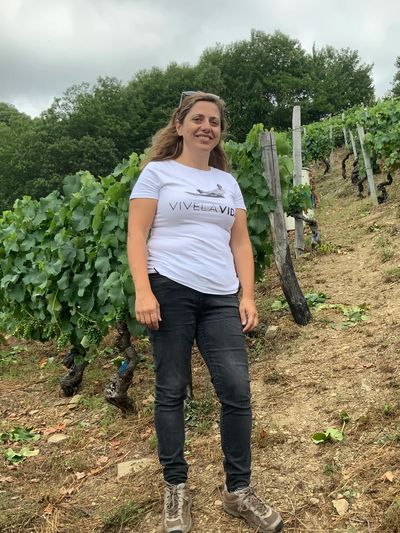Siete Vidas - Cangas
Visiting Siete Vidas is like traveling to the middle ages. Similar in many ways to Galicia, but more remote, Asturias is green and wet, with stone hovels and wood smoke always in the air. Cangas del Narcea and the surrounding areas were important viticulturally from the 11th century until 1950, when coal mining abruptly stopped cultivation, dropping from 3 million kilos of grapes per year to its current 100,000. Cangas native Beatriz Pérez is working to revive local wine culture. She cares for many of the few remaining plots of vines, entrusted to her by older locals, too old to tend them on their own, and is also planting new vineyards. She is on a quest to show what Cangas can do!
Siete Vidas Albarín Blanco 2020
80% Albarín Blanco/15% Palomino/5% Albillo from organic in practice vineyards with extreme viticulture in every way: rocky, slate soils which slip under your feet, steep slopes with as much as 75% grades, warm and wet in the summer, snow in the winter.
Winemaking: Stainless fermented and aged. Spontaneous native yeast fermentation. Low total SO2 (15 ppm).
Production: 200 cases
Siete Vidas “Tinto” 2020
50% Mencía/30% Albarín Negro/15% Carrasquín/5% Verdejo Negro (Trousseau) from 30-60 year old organic in practice vineyards.
Winemaking: Stainless fermented and aged. Low total SO2 (10 ppm).
Production: 416 cases
Siete Vidas Parcelas Singulares 2021
40% Albarín Negro/30% Carrasquín/30% Verdejo Negro from 30-60 year old organic in practice vineyards.
Winemaking: Aged in a used, 3,000 liter French foudre for 7 months. Low total SO2 (20 ppm).
Production: 330 cases

Instagram: @bodegavidas
Professional Reviews
RP92 - Siete Vidas Albarín Blanco 2023
Reviewed by: Luis Gutiérrez
Issue Date: August 8, 2024
I love the flinty and reductive nose of the varietal white 2023 Siete Vidas Albarín Blanco, a young unoaked white where they want to show the character of the variety naked and without makeup. It fermented with indigenous yeasts in stainless steel and was kept with the lees for a few months. This is closer to some examples of the variety I've tried from Galicia, where the grape is known as Branco Lexítimo and produces some characterful wines. It's mineral and austere, with an absence of fruit and a rocky profile. It has a moderate 12.5% alcohol and a pH of 3.36. It is tasty, with pungent flavors, fresh and with a long and dry finish with a salty twist. 4,000 bottles produced. It was bottled in May 2024.
RP90 - Siete Vidas Tinto 2023
Reviewed by: Luis Gutiérrez
Issue Date: August 8, 2024
The red blend 2023 Siete Vidas Tinto was produced with 40% Albarín Negro (Caíño), 40% Mencía, 10% Verdejo Negro (Trousseau) and 10% Carrasquín. It's an unoaked wine that makes homage to the traditional reds from Cangas. It's easy to drink, has moderate alcohol (12.4%) and good freshness and acidity. It's perfumed, primary and clean, with notes of honey, beeswax and red berries. It has a medium-bodied palate with almost unnoticeable tannins. Very easy to drink. 6,600 bottles produced. It was bottled in May 2024.
RP91 - Siete Vidas Parcelas Singulares 2022
Reviewed by: Luis Gutiérrez
Issue Date: August 8, 2024
The 2022 Siete Vidas Parcelas Singulares was produced with a blend of 40% Albarín Negro (Caíño), 30% Mencía and 15% each Verdejo Negro (Trousseau) and Carrasquín from selected plots of old vines. It fermented in a 3,000-liter French oak foudre where the wine matured for 10 months. It has a shy nose with notes of wild berries, herbs and flowers and some spiciness. The palate is medium-bodied, with fine tannins, medium ripeness and alcohol (12.15% alcohol) and good freshness and balance, finishing clean. 4,000 bottles produced. It was bottled in May 2024.
